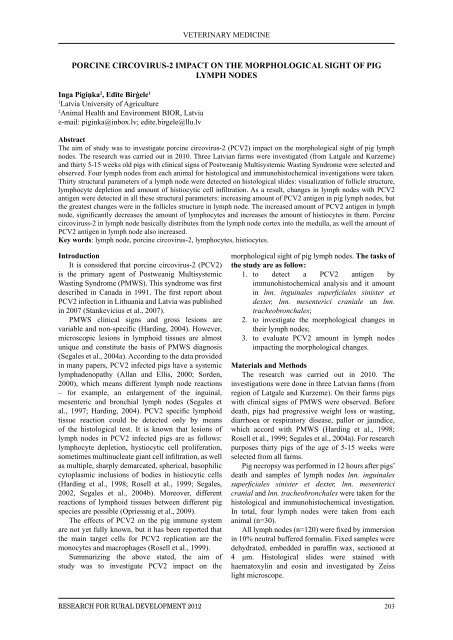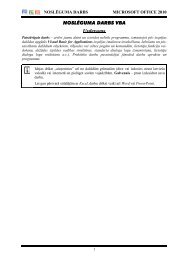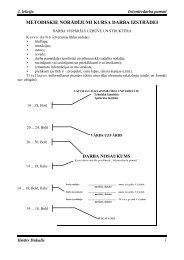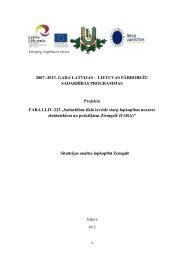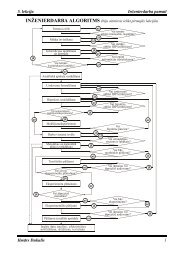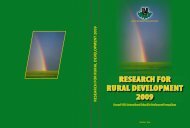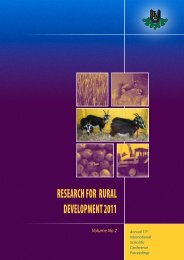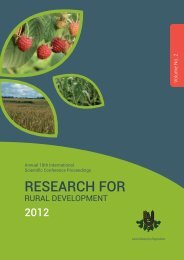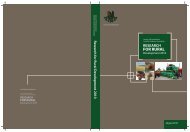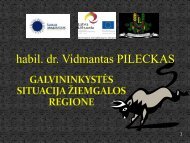LATVIA UNIVERSITY OF AGRICULTURE - Latvijas ...
LATVIA UNIVERSITY OF AGRICULTURE - Latvijas ...
LATVIA UNIVERSITY OF AGRICULTURE - Latvijas ...
- No tags were found...
You also want an ePaper? Increase the reach of your titles
YUMPU automatically turns print PDFs into web optimized ePapers that Google loves.
VETERINARY MEDICINEPORCINE CIRCOVIRUS-2 IMPACT ON THE MORPHOLOGICAL SIGHT <strong>OF</strong> PIGLYMPH NODESInga Pigiņka 2 , Edīte Birģele 11Latvia University of Agriculture2Animal Health and Environment BIOR, Latviae-mail: piginka@inbox.lv; edite.birgele@llu.lvAbstractThe aim of study was to investigate porcine circovirus-2 (PCV2) impact on the morphological sight of pig lymphnodes. The research was carried out in 2010. Three Latvian farms were investigated (from Latgale and Kurzeme)and thirty 5-15 weeks old pigs with clinical signs of Postweanig Multisystemic Wasting Syndrome were selected andobserved. Four lymph nodes from each animal for histological and immunohistochemical investigations were taken.Thirty structural parameters of a lymph node were detected on histological slides: visualization of follicle structure,lymphocyte depletion and amount of histiocytic cell infiltration. As a result, changes in lymph nodes with PCV2antigen were detected in all these structural parameters: increasing amount of PCV2 antigen in pig lymph nodes, butthe greatest changes were in the follicles structure in lymph node. The increased amount of PCV2 antigen in lymphnode, significantly decreases the amount of lymphocytes and increases the amount of histiocytes in them. Porcinecircoviruss-2 in lymph node basically distributes from the lymph node cortex into the medulla, as well the amount ofPCV2 antigen in lymph node also increased.Key words: lymph node, porcine circovirus-2, lymphocytes, histiocytes.IntroductionIt is considered that porcine circovirus-2 (PCV2)is the primary agent of Postweanig MultisystemicWasting Syndrome (PMWS). This syndrome was firstdescribed in Canada in 1991. The first report aboutPCV2 infection in Lithuania and Latvia was publishedin 2007 (Stankevicius et al., 2007).PMWS clinical signs and gross lesions arevariable and non-specific (Harding, 2004). However,microscopic lesions in lymphoid tissues are almostunique and constitute the basis of PMWS diagnosis(Segales et al., 2004a). According to the data providedin many papers, PCV2 infected pigs have a systemiclymphadenopathy (Allan and Ellis, 2000; Sorden,2000), which means different lymph node reactions– for example, an enlargement of the inguinal,mesenteric and bronchial lymph nodes (Segales etal., 1997; Harding, 2004). PCV2 specific lymphoidtissue reaction could be detected only by meansof the histological test. It is known that lesions oflymph nodes in PCV2 infected pigs are as follows:lymphocyte depletion, hystiocytic cell proliferation,sometimes multinucleate giant cell infiltration, as wellas multiple, sharply demarcated, spherical, basophiliccytoplasmic inclusions of bodies in histiocytic cells(Harding et al., 1998; Rosell et al., 1999; Segales,2002, Segales et al., 2004b). Moreover, differentreactions of lymphoid tissues between different pigspecies are possible (Opriessnig et al., 2009).The effects of PCV2 on the pig immune systemare not yet fully known, but it has been reported thatthe main target cells for PCV2 replication are themonocytes and macrophages (Rosell et al., 1999).Summarizing the above stated, the aim ofstudy was to investigate PCV2 impact on themorphological sight of pig lymph nodes. The tasks ofthe study are as follow:1. to detect a PCV2 antigen byimmunohistochemical analysis and it amountin lnn. inguinales superficiales sinister etdexter, lnn. mesenterici craniale un lnn.tracheobronchales;2. to investigate the morphological changes intheir lymph nodes;3. to evaluate PCV2 amount in lymph nodesimpacting the morphological changes.Materials and MethodsThe research was carried out in 2010. Theinvestigations were done in three Latvian farms (fromregion of Latgale and Kurzeme). On their farms pigswith clinical signs of PMWS were observed. Beforedeath, pigs had progressive weight loss or wasting,diarrhoea or respiratory disease, pallor or jaundice,which accord with PMWS (Harding et al., 1998;Rosell et al., 1999; Segales et al., 2004a). For researchpurposes thirty pigs of the age of 5-15 weeks wereselected from all farms.Pig necropsy was performed in 12 hours after pigs’death and samples of lymph nodes lnn. inguinalessuperficiales sinister et dexter, lnn. mesentericicranial and lnn. tracheobronchales were taken for thehistological and immunohistochemical investigation.In total, four lymph nodes were taken from eachanimal (n=30).All lymph nodes (n=120) were fixed by immersionin 10% neutral buffered formalin. Fixed samples weredehydrated, embedded in paraffin wax, sectioned at4 μm. Histological slides were stained withhaematoxylin and eosin and investigated by Zeisslight microscope.Research for Rural Development 2012203


